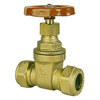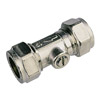Draining & Isolating The Plumbing System
Introduction
If you are planning on carrying out any work on the plumbing system, or if you detect a leak, then you will need to drain at least part of it before you can commence work.
If you have detected a leak then you will need to be able to do this quite quickly, it helps if you have detected in advance the mains water stopcock and/or any necessary valves before hand.
If you plan to leave your property empty for an extended period in winter, and if it is not applicable to leave the heating on low during this time, then it is advisable to drain the entire system as a precaution to prevent freezing and any potential damage this may incur.
Before commencing work, make sure you have all the tools you need to successfully complete the job. Use the following link for a list of basic plumbing tools:
Draining the entire system
To completely remove all water from the plumbing system, follow these steps:
- Turn off and/or extinguish your water heater/boiler
- Turn off the mains water supply at the stopcock
- Run all the taps in the property, and flush the toilets too
- Empty the hot water cylinder by opening the draincock at it's base - attach a hosepipe to the draincock and run the water into a drain or bucket
- Empty the rising main, and any low pipework if applicable, by opening their draincocks
- If you are draining the system for winter
Put salt into the WC pan to prevent water in the trap from freezing
Fitting additional valves
When the system has been partially or fully drained, this is often a great time to fit additional valves to make isolating the plumbing a much simpler job in the future. Without these valves it can mean having to drain the entire system just to change a washer in a tap!

Gate valves can be fitted on the cold feed pipes exiting the cold water storage tank. This makes isolating pipes and fixtures in an indirect low pressure system a lot easier as there is no need to drain gallons of water before commencing work.

Miniature valves are ideally fitted to the supply pipes to any tap, fixture or appliance in either a direct or indirect system. This makes isolating the individual part of the system so much more straightforward.
Refilling the system
To refill the system once any work has been completed, do the following:
- Open the mains water stopcock
- Turn on all taps to allow air to escape the system
- Close the taps once only water is flowing from them, ie they have stopped spluttering
- Check that float valves (ball cocks/valves) in water storage tanks and WC cisterns are working correctly
Sometimes after refilling the system, one or more taps may continue to splutter, this is caused by an airlock in the system. To cure this the best thing to do is to use higher pressure water to force the airlock out of the system. To do this:
- Attach a length of hose between a mains-fed cold water tap (ie the kitchen tap) and the spluttering tap
- Open both taps and let them run through the hose for a few minutes
- Turn off the taps and disconnect the hose. Run the spluttering tap - hopefully the splutter has gone, if not repeat the process a few times
Draining the cold water storage tank
This is often only necessary if there is not a valve in the system to isolate this tank.
- Turn off the mains water at the stopcock and close the valve to the rising main
- In an indirect (stored water) system open the all the cold taps in the/a bathroom until the water stops
- In a direct, mains fed system turn off the boiler and open the all the hot taps until the water stops
- Bail out any remaining water with a small bucket, or similar
Draining the hot water cylinder
This is not something that one needs to do often, however if the cylinder needs replacing or has sprung a leak then it will need to be drained.
- Turn off the cold water supply from the cold storage tank by closing the valve between the tank and the cylinder
- If the cold water storage tank does not have a close valve in the pipework that exits the tank, then it too will need to be drained - see above
- Locate the draincock at the base of the cylinder, attach a hose, open the valve, and drain the water into a sink or bucket that is lower than the cylinder
- If you are replacing the cylinder, ensure it is fully drained before disconnecting ant attached pipework.
- If the cylinder contains a heat exchanger to heat the water, this will be inside the cylinder and will still contain water. This can be drained via a stopcock on the boiler once all water supplies to the boiler have been shut of, or drained themselves
Draining the cold water supply
If you are planning on replacing a tap, shower, wc cistern etc, then the fixture will need to be isolated and all relevant pipework drained. If the item does not sit between isolating valves then the entire cold water system will need to be drained.
- Turn off the mains water at the mains stopcock (in an indirect system this will stop the rising main water from flowing up to the storage tank in the loft)
- On a direct system this will remove the water pressure to all the cold taps in the system. Open the taps to drain the pipework
- If you haven't been able to locate the mains stopcock but still urgently need to drain the system, then in an indirect system place a wooden batten across the top of the cold water storage tank and tie the float valve (ball cock/valve) to it
- In an indirect system, the cold water storage tank will need to be isolated first. To do this, close the valve in the pipework exiting the tank.
- If the cold water storage tank does not have a close valve in the pipework that exits the tank, then it too will need to be drained - see above for guide
- Once the storage tank is isolated, open the tap/shower or flush the toilet a few times to drain the pipework
Draining the hot water supply
If you are planning on replacing a hot tap or shower mixer then the fixture will need to be drained along with any relevant pipework.
- Turn off and/or extinguish your water heater/boiler
- In a direct system, simply close the valve to isolate the boiler, then run the hot tap to drain the pipework
- In an indirect system, close the valve between the cold water tank and the hot water cylinder, then run the hot taps
- This will drain the hot water pipes leading to the taps, but leave the hot water cylinder full as the back pressure from the closed valve will keep the water in the cylinder. If the valve leaks air slightly then the hot water may slowly drip through!
- If the cold water storage tank does not have a close valve in the pipework that exits the tank, then it too will need to be drained - see above
- The feed to the cold water storage tank can be stopped by placing a wooden batten across the top of the cold water storage tank and tying the float valve (ball cock/valve) to it rather than locating and closing the mains stopcock
- Ensure that when emptying the cold water tank you keep the hot taps closed. If you open the hot taps before the cold you will empty the hot cylinder instead. If you are in a hurry to drain the hot water system then open both hot and cold taps - this may keep some hot water in the cylinder for you
- Once the cold water tank is empty, open the hot taps and drain the pipework
Draining a WC cistern
If you are replacing the cistern, or repairing a crack, it is necessary to drain the cistern
- To simply empty the cistern, place a wooden batten across the top of the cistern and tie the float valve (ball cock/valve) to it. Flush the toilet to empty the cistern
- To empty the pipework that feeds the cistern, either turnoff the mains stopcock in a direct system and flush the WC, or in an indirect system isolate the cold water storage tank, by closing the exit valve, and then flush the WC a few times
- If the cold water storage tank does not have a close valve in the pipework that exits the tank, then it too will need to be drained - see above
- The feed to the cold water storage tank can be stopped by placing a wooden batten across the top of the cold water storage tank and tying the float valve (ball cock/valve) to it, rather than locating and closing the mains stopcock
Further information and useful links
- Find a Plumber near you
Site Pages
Featured Articles





